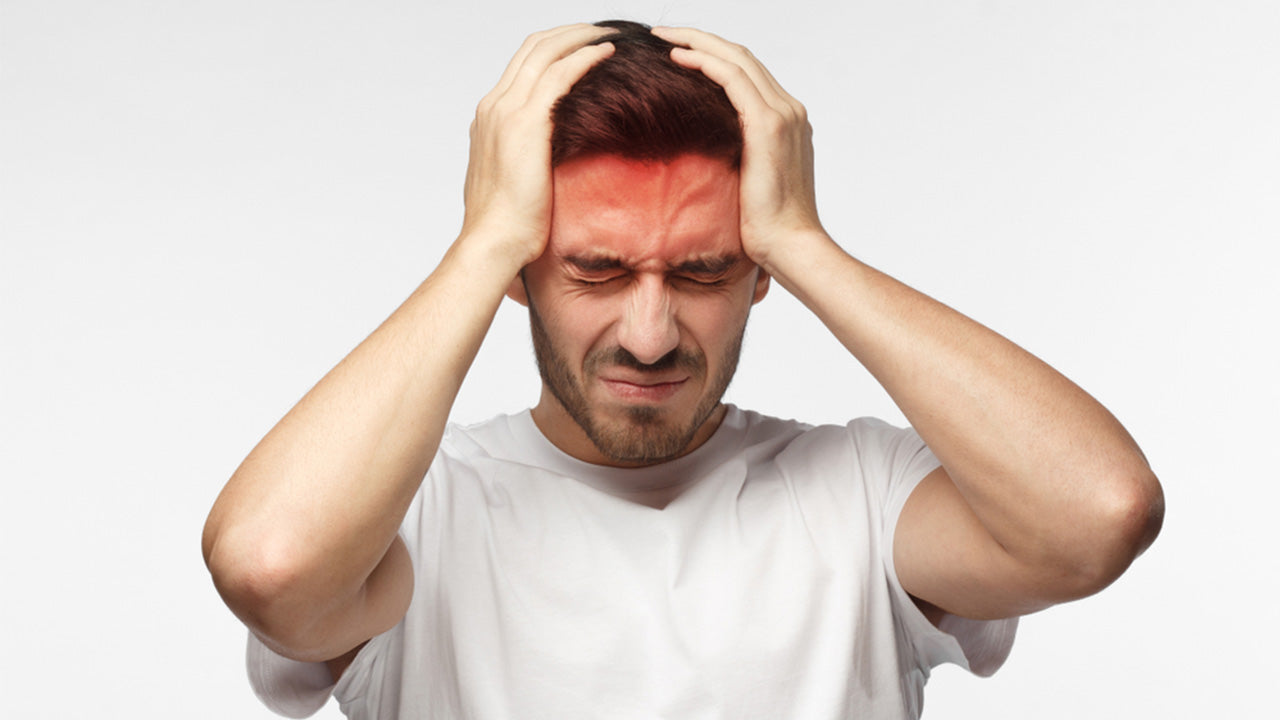10 Home Remedies for Headaches: How to Cure a Headache and Find Relief Fast
 By: by Amino Science
By: by Amino Science

Who in the modern world hasn’t experienced a headache from time to time? Whether you’re dealing with a minor annoyance or a nauseating pain that sends you to a dark room to lie down, all you want is relief. And many of us reach for over-the-counter pain relievers to get us through. But drugs just mask the pain—and many can have nasty side effects as well. So if you’re tired of simply treating the symptoms, we invite you to check out these 10 home remedies for headaches. Whether your problem is tension or you’re plagued by the throbbing pain of a migraine, we might just have the headache relief you’ve been searching for.
Types of Headaches
Believe it or not, experts estimate that there are over 300 types of headaches, but all of them fall into one of two classes: secondary or primary. Secondary headaches are a symptom of an underlying medical problem and include benign forms like ice cream and sinus headaches as well as types that are associated with life-threatening situations such as tumors and aneurysms.
By contrast, primary headaches are the result of overactive or malfunctioning pain-sensitive structures in the head. These types of headaches aren’t related to any known structural abnormality, and they make up more than 90% of all headaches. The most common types of primary headache are:
- Tension headaches
- Migraine headaches
- Trigeminal autonomic cephalalgias
- Other primary headaches
Tension Headaches
The tension headache takes home the prize for the most common type of headache. This is the type of headache that’s responsible for the feeling of tightness around the head that can make you feel like your skull is in a vise. Lasting anywhere from 30 minutes to several days, tension headaches typically produce a dull, squeezing pain on both sides of the head that may travel down into the neck and shoulders as well.
The symptoms of tension headaches may sometimes overlap with those of migraines and can make the two difficult to tell apart. Tension headaches can also be triggered by a variety of factors but are most commonly associated with stress.
Migraine Headaches
Migraines are severe headaches whose cause is quite complex and still not well understood. However, the condition is believed to be the result of a neurological disorder involving nerve pathways and brain neurotransmitters, including serotonin.
According to the Migraine Research Foundation, almost 40 million Americans are living with migraines, and women are 3 times more likely than men to have the disorder.
Migraine attacks may last between 4 and 72 hours and be accompanied by throbbing pain, sensitivity to light, nausea, and vomiting. Symptoms generally occur on only one side of the head, though both sides may be affected.
Trigeminal Autonomic Cephalalgias
This headache group is characterized by moderate to severe pain on one side of the head, accompanied by additional symptoms on the same side that may include tearing, eye redness, runny or stuffy nose, or eyelid drooping.
The most common of the trigeminal autonomic cephalalgias are cluster headaches, which can occur several times a day for several weeks. While cluster headaches were once thought to occur 5 to 6 times more often in men than women, the National Organization for Rare Disorders (NORD) now estimates that the ratio is closer to 2:1.
Other Primary Headaches
The least common types of primary headaches belong to the “other” category. These include cough headaches, which can cause sharp, stabbing pain, and exercise and sex headaches, which can cause a dull ache or throbbing pain.
10 Home Remedies for Headaches
Whether you’re suffering from a secondary or primary headache, the only thing you’re probably thinking about is relief. So with that in mind, we now offer 10 proven headache remedies that can help relieve your pain quickly and naturally.
1. Hot and Cold Compresses
If you’re suffering from a tension headache, a hot compress can help relax your muscles and bring soothing pain relief. But if you’re dealing with migraine pain, you may want to use a cold compress instead. Not only does cold reduce inflammation and slow nerve conduction, but a 2013 study also found that placing an ice pack on the neck at the onset of a migraine can significantly reduce pain symptoms.
2. Ginger
The use of ginger root for medicinal purposes goes back thousands of years. And now modern science has demonstrated that ginger has anti-inflammatory properties, including the ability to block the prostaglandins that contribute to inflammation and pain, that make it useful in the treatment of headache pain.
In fact, a 2014 study found that ginger is as effective at providing migraine relief as the prescription medication sumatriptan—but without the side effects. As an added plus, ginger is also successful in reducing the symptoms of nausea that often accompany migraine attacks.
To reap the many benefits of ginger, try consuming the root in capsule form, or make your own ginger tea by adding a tablespoon of freshly grated ginger root to boiling water and allowing it to steep for 10 to 15 minutes. While ginger tea has a lovely warm and spicy flavor on its own, you can also mix in a little honey to sweeten the brew.
3. Magnesium
According to the World Health Organization (WHO), an estimated 75% of Americans are deficient in magnesium. And studies have shown that many people who suffer from chronic headaches, including migraines, are lacking in this important mineral.
Moreover, a 2018 study demonstrated that the use of supplemental magnesium may be helpful in preventing migraine attacks, and the American Migraine Foundation recommends that 400 to 500 milligrams of magnesium be taken each day to help prevent and treat migraines.
4. Tart Cherries
Tart cherries contain phytochemicals called anthocyanins that block inflammation and inhibit pain enzymes. What’s more, these phytochemicals can inhibit the breakdown of the amino acid tryptophan, which serves as a precursor of serotonin. As discussed earlier, serotonin is thought to be involved in migraine pain. To get the benefits of tart cherries, have a snack of 20 or so of the tasty fruits or drink an 8-ounce glass of tart cherry juice.
5. Essential Oils
Both peppermint and lavender essential oils possess antispasmodic and analgesic properties that make them effective in fighting headache pain. A 2016 study found that topical application of peppermint oil is as effective as aspirin and acetaminophen in reducing the spasms associated with tension headaches. And a 2012 clinical trial found that inhaling lavender oil led to partial or complete reduction in migraine symptoms in approximately 70% of study participants.
6. Coenzyme Q10
Coenzyme Q10 (CoQ10) is a powerful antioxidant that helps generate energy in the body’s cells. And several studies have shown that supplementing with this important nutrient may be helpful in treating and preventing migraines.
For example, a 2017 study found that 100 milligrams of CoQ10 a day helps reduce the frequency, length, and severity of migraine events without side effects. And a study from 2005 found that the antioxidant can help reduce symptoms of nausea as well.
7. Water
Dehydration is a known trigger of many types of headaches, including tension and migraine headaches. According to the National Academies of Sciences, Engineering, and Medicine, an adequate daily intake of water is around 11-1/2 cups for women and 15-1/2 cups for men. So if you feel a headache looming, pour yourself a tall glass of water and drink up.
8. Caffeine
After discussing the importance of avoiding dehydration, it might seem strange to then recommend caffeine for a headache. But the truth is that caffeine helps constrict the blood vessels that become dilated during headaches, which is why it’s a common ingredient in many headache medications.
Moreover, a 2017 study found that while caffeine can effectively treat both primary and secondary headaches, when used in combination with over-the-counter analgesics, it significantly improves the efficacy of these drugs.
However, like other analgesics, excessive use of caffeine can lead to medication-overuse headaches, so watch your consumption—and be sure to drink plenty of the aforementioned water to make up for the dehydrating effect of caffeine.
9. Stretch and Massage
Muscle tension plays a role in many different types of headaches. And with our modern use of computers and cell phones, we’re constantly putting strain on our neck muscles. A study from 2010 found that a 12-month program of stretching can reduce headache symptoms by 37%. And adding strengthening exercises to the mix can improve relief by an astounding 69%.
To minimize the stress that leads to headaches, take a break from the computer or cell phone every 30 minutes or so and rotate your head and neck in a circular motion to loosen the muscles and relieve built-up tension. For even further relief, try kneading the muscles in the back of the neck and along the sides, where tension tends to build.
10. Meditation
Several studies have shown that meditation may be useful in preventing tension headaches and migraines. In fact, a recent meta-analysis demonstrated that mindfulness meditation is indeed effective in reducing both the severity and frequency of headaches.
So the next time you’re hit with a headache, don’t let headache pain ruin your day. Natural remedies may be all you need to get back to feeling like your old self again.
However, headaches can sometimes be a symptom of a more serious condition, so if you experience what feels like the worst headache of your life, a stiff neck, or difficulty speaking or walking, don’t hesitate to seek immediate medical attention.
 Do Amino Acids Hold the Migraine Key?
Do Amino Acids Hold the Migraine Key?
There is much to learn about migraines and their treatment and prevention, but a 2018 study suggests that migraines and amino acids are intricately intertwined (1). Specifically that levels of serotonin and 9 amino acids are significantly reduced during a migraine attack and that therapeutic management of these specific pathways may hold the key to prevention and treatment.
Your body depends on you to give it a balanced supply of all essential amino acids. If you are struggling with migraines and could benefit from nutritional support, then visit our product page to learn more about our targeted amino acid supplements designed to support the needs of your brain and body.

Up to 25% off Amino
Shop NowTAGS: conditions natural cures
Join the Community
Comments (0)
Most Craveable Recipes




 833-264-6620
833-264-6620



















